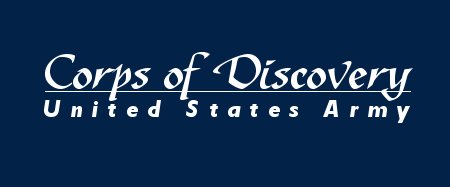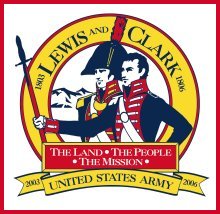Recruitment At Ft. Massac
November 12, 1803
A small contingent of men led by Captains Lewis and Clark arrived at Ft. Massac, a small fort overlooking the Ohio River not far above its confluence with the Mississippi River. While at Ft. Massac Lewis, armed with orders from Secretary of War Henry Dearborn, selected men for possible recruitment into the permanent expedition party.
Here, Captain Lewis and fort commander Captain Daniel Bissell review potential candidates on the parade ground outside the north gates of the fort. Standing with them is the French/Indian interpreter and hunter, George Drouillard, who was the most valuable addition the Corps recruited at Ft. Massac. A total of fourteen men were gathered to navigate Lewis's boats up the river; perhaps as few as two actually became Corps of Discovery members.
Independence Creek
July 4, 1804
At the mouth of Independence Creek near present day Atchison, Kansas, the Corps of Discovery took time from their daily routine of back breaking labor to celebrate the twenty-eighth birthday of their fledgling new republic. That evening they turned out in full dress uniform to mark the significance of the day. The men cheer as the swivel gun on the keelboat is fired to bring the fourth to a close. A small keg of whiskey has been brought out to provide each man an extra gill to further enhance the celebration.
Pursuit of the Sioux
February 16, 1805
On February 14, 1805 four men, George Drouillard and privates Robert Frazer, Silas Goodrich and John Newman were on a detail from Ft. Mandan to collect and bring back meat. About 25 miles downstream from the fort they were stopped and robbed by a party of hostile Sioux, estimated by William Clark to number 106. After making their way back to the fort with this bad news, a force of twenty volunteers was quickly assembled and at dawn on the 15th, under the leadership of Captain Lewis, set off in pursuit. The next morning the near-frozen men saw a column of smoke rising into the fridgid air. The Sioux, after overnighting in the earthern lodges of an abandoned Mandan village, set fire to them as they left. Not finding the Sioux, the men then hunted to replenish their fresh meat supply.
Bestride the Mighty Missouri
August 12, 1805
As the rest of his companions look on, Hugh McNeal puts one moccasined foot on each side of a small rivulet of water high in the Rocky Mountains just beneath the Continental Divide, thrusts his musket skyward, lifts his head "...and thanked his God that he had lived to bestride the mighty and heretofore deemed endless Missouri." (Journal entry of Captain Lewis, August 12, 1805.)
By this time the uniform clothing of the men had been well used up and they resorted to animal skin clothing copied from their Mandan hosts during the Winter of 1804-1805. Guide George Drouillard is to McNeal's right.
Trade at Dismal Niche
November 11, 1805
November 11, 1805 was described by Captain William Clark in his journal as being "...a truly disagreeable one..." but that scarcely covers the situation. After days of rain and wind the Corps of Discovery was trapped on a wave-lashed stretch of shore, just miles from their ultimate goal - the Pacific Ocean. Their clothes were rotting from their backs and their food supply had been reduced to pounded fish.
As they struggled to improve their situation, they were astonished to see a small canoe with five Indians paddle into the cove through "...tremendous waves breaking with great violence against the shores...", Clark's journal noted. These Indians, most likely Chinooks, had fresh salmon to trade and in return for 13 of them, they received fish hooks and other "trifling things". This gave the Corps the first fresh food they'd tasted in days.
The cove that sheltered them is almost directly across the river from present day Astoria, Oregon and the steep hillsides that hemmed them in are now cut by Highway 401 which follows the river.





